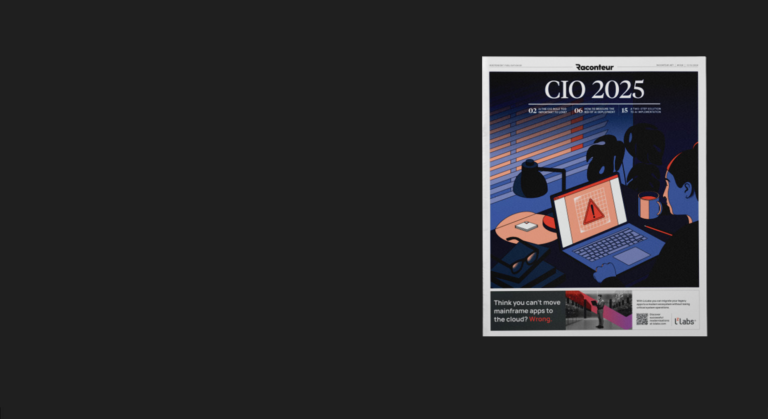How can legacy IT modernisation be less of a challenge and more of an opportunity? And what are practical approaches to implementation that help reduce risk and deliver incremental business value? These and other related questions will be answered in the following sections.
Q: Why should anyone transition from the mainframe to other platforms?
A: As the adage says: “If it ain’t broke, don’t fix it.” When it comes to legacy modernisation, that’s a somewhat risky attitude. Companies who want to keep up with the world around them need to develop a sense of urgency regarding modernising their IT estate. A wiser adage says: “What is new today in terms of technology is going to be old tomorrow.” If you don’t adapt now or at least pave the way for modernisation, you will struggle later. IT modernisation is an ongoing requirement and a vital undertaking for any business that wants to remain competitive. The longer you leave it, the more demanding – and the more expensive – it may get.
Q: Is the mainframe about to disappear?
A: Mainframe systems have been predicted to disappear several times, yet many organisations still depend on the mainframe applications for their critical business processes – particularly banks, insurance, healthcare, etc. That is the prime reason why the mainframe is more steadfast than some people think. If an organisation believes it can and will innovate on the mainframe, so be it; that’s their choice. However, mainframe systems not only suffer from the drawbacks of vendor lock-in; they also tend to hold businesses back from becoming more agile and moving forward in the marketplace.
Q: Is mainframe transformation an easy exercise?
A: The mainframe transformation is quite a challenge, but it is doable. Due to the nature of the mainframe and its architecture, mainframe innovation is subtly different from other IT transformation endeavours. The best approach to successful mainframe transformation is to see it as a journey to new opportunities. Please consider this transformation regarding the scalability and agility it brings to your business. Any organisation wary of the transition cost needs to be aware of the long-term cost and detrimental impact of remaining dependent on their legacy IT. Therefore, the most pressing question is not if but how this transition can be achieved.
Q: Is the IT transformation limited to the mainframe?
A: Any system environment suffering from old age or disparities across systems – often resulting from mergers and acquisitions – is a contender for modernisation. The transformation journey is happening; anyone who ignores it is bound to lose out. Modern tools and technologies – expertly deployed by experienced partners – help accelerate this transformation while mitigating the risks involved.
Q: What can typically go wrong in a mainframe modernisation and transformation project?
A: There are many pitfalls along the way. The complexities involved in mainframe modernisation should never be underestimated. However, you might want to ask yourself: Is the mainframe your platform of innovation? – as outlined in our recent whitepaper.
Q: Where are things going?
A: It doesn’t matter that much whether it’s the cloud or your own data centre, whether it is Linux or Windows or whatever platform. What matters is the value in the applications on which the business relies and in the data that fuels innovation. Therefore, organisations should ask themselves how to embed DevOps and agile methodologies in their transformation journey. Organisations should not hesitate to use new tools, embrace modern methods and processes, and start experimenting with them and adopt them today – even within the imposed limits of their current environment.
There is promising news, too: For instance, IBM announced that its Watson AI will adapt to the COBOL language. This move will support developers in rewriting and restructuring the entire COBOL ecosystem from the mainframe era.
Q: What are some successful strategies or methodologies for organisations aiming to rebuild or rearchitect their mainframe applications while preserving compatibility with existing systems?
A: First, you need to know your current position before defining where you want to drive your organisation’s transformation journey. Only then can you set the course for your modernisation journey. Be sure to define your North Star metric so you can measure, track and report progress along the route. It would be best if you had a thorough understanding of what is driving your organisation’s transformation journey and how you and your team can secure the buy-in of executive stakeholders.
Don’t make it a five-year journey. Break it down into achievable chunks, demonstrate what is being achieved, and score quick wins along the way. Keep things adaptive. Once you go down a path, you will keep learning and adjusting. Be aware that there is neither a silver bullet nor a no one-size-fits-all solution to mainframe modernisation. Success in mainframe modernisation and transformation typically demands a prudently selected mix of Rs. The general idea is to preserve what can be preserved and only change, replace, or migrate what has to be changed, replaced, or migrated. Organisations looking to reduce their dependence on the mainframe should focus on integration and open systems to avoid lock-in.
The right mindset is another critical success factor in mainframe modernisation. Be sure to take your entire team on board. Whether it’s your business team, your IT team or your application team –they need to be part of it and join in on that change. You need to define and articulate your vision and ideas clearly and, of course, the benefits these will bring to the company in the foreseeable future.
Q: Are there any real-world success stories that can be shared?
A: Yes, there are quite a few. For instance, a global automotive manufacturing company suffered from mainframe capping, impacting critical business processes. To overcome this issue, the company decided to rehost several business-critical applications to the cloud while retaining its databases on the mainframe. However, the company’s data centre was located quite far from where the cloud systems were running. There were latency issues with transactions going back and forth millions of times between both places. These issues were resolved through rewriting, rebuilding and innovative thinking about replicating some of the data so that only the updates needed to be transferred. Even though transaction speed was slightly lower than in the legacy all-mainframe environment, the overall process speed increased significantly because capacity limits and queuing were gone for good.
Q: How does the 7Rs framework impact the total cost of ownership reduction for mainframe systems and enhance overall operational efficiency?
A: TCO reduction is a critical driver in many cases. However, the seven Rs as such will not necessarily reduce the total cost of ownership. Also, operational efficiency is essential, but it’s not the only goal. For instance, if you want to grow your business, other aspects matter: You are looking to develop additional revenue streams, you want greater flexibility, you need more integration, and you want to be able to disrupt and respond to new circumstances.
These are the things that ultimately will drive IT modernisation. The art is in doing it most cost-effectively, but this will not happen just by choosing a specific target platform. Instead, it will happen through collaboration as a cross-disciplinary team effort.
Q: How do you address security concerns when modernising mainframe systems using this 7R approach?
A: Mainframes are designed to be highly secure – but are they always secure? Experience shows that organisations sometimes fail to employ some of the protection mechanisms available on the mainframe. Companies need to assess their vulnerabilities and the risks they are exposed to in the event of a security breach. But what if the enemy is already inside? It’s time to give up on the idea of building castles as a protection mechanism.
Security must be looked at from various angles. For instance, the security strategy needs to address issues such as the regulatory implications of where the data is located and from where it is accessed. After all, the customer’s data belongs to the customer in view of the GDPR and other international and national regulatory requirements. Shortcuts are not permissible. Regardless of the platform, adequate security needs the attention of and collaboration between the business and IT. Striking a well-thought-out balance between control and cost is the best way to go.
The business and IT need to partner to understand what security issues and solutions exist today and the potential security impact when the system environment changes. This understanding is indispensable when a company prepares to embark on its journey away from the mainframe.
Q: Is there a mainframe transformation success story from the banking sector?
A: The key to mainframe migration success is to move incrementally. For instance, it’s a good idea to start with the system test environment and offer the developers ways to do more testing without impacting the mainframe or the current application suite. A customer in the banking sector is doing it the other way around. They are moving the applications into the Java world while keeping the data in the LzLabs Software Defined Mainframe (SDM) environment, thus replacing the DB2 but keeping the data consistent.
Key learnings: Be sure to brace for change during the modernisation project and adjust your course of action. As soon as you use complex replication or synchronisation mechanisms, things can become extremely tedious. Compatibility and integration are important. Mainframe migration is a continuous process that calls for an incremental approach. And, finally, even Java is gradually becoming a legacy language.
Q: What risks are associated with the status quo?
A: Some think the status quo is great – everything works as expected. However, anyone who chooses to stand still is falling behind. Even though things may be working fine now, companies that want to remain relevant must anticipate change. The risks of staying in the status quo tend to be grossly underestimated. You may think you’re in control but you’re not. And the decision is ultimately: Are you modernising, or are you being modernised? The latter is probably not the state you want to be. You want to be in the driver’s seat.
Q: What is a good way of getting people aligned for innovation?
A: Plan for a step-by-step approach. Define small, realistically achievable goals along the journey. Don’t make it a five-year journey with its destination out of sight. Go for smaller-scale plans instead. What can we achieve in a month? What can we achieve in a quarter? And if that translates into tangible results that can be presented to executive stakeholders, magic will likely happen.
Many large-scale projects that go with a huge budget and a multiple-year timeframe falter; they are overengineered and oversized, making everyone involved feel a heavy weight on their shoulders. It’s much smarter to keep things lighter and let everyone see what happens each month or quarter. Jointly achieved wins will motivate and encourage people to continue the journey to project success.



